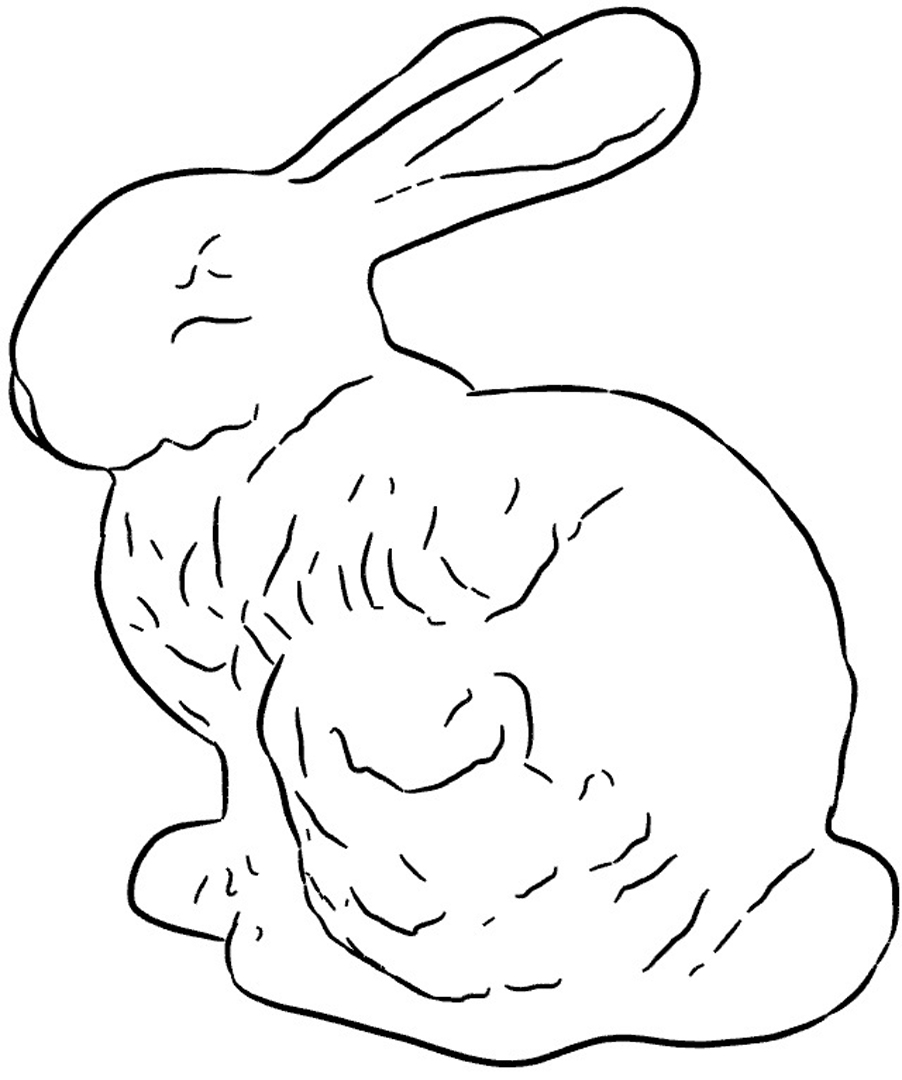“Suggestive contours for conveying shape” by DeCarlo, Finkelstein, Rusinkiewicz and Santella
Conference:
Type(s):
Title:
- Suggestive contours for conveying shape
Presenter(s)/Author(s):
Abstract:
In this paper, we describe a non-photorealistic rendering system that conveys shape using lines. We go beyond contours and creases by developing a new type of line to draw: the suggestive contour. Suggestive contours are lines drawn on clearly visible parts of the surface, where a true contour would first appear with a minimal change in viewpoint. We provide two methods for calculating suggestive contours, including an algorithm that finds the zero crossings of the radial curvature. We show that suggestive contours can be drawn consistently with true contours, because they anticipate and extend them. We present a variety of results, arguing that these images convey shape more effectively than contour alone.
References:
1. APPEL, A. 1967. The notion of quantitative invisibility and the machine rendering of solids. Proceedings of ACM National Meeting, 387–393. Google Scholar
2. CANNY, J. 1986. A computational approach to edge detection. IEEE PAMI 8, 6, 679–698. Google ScholarDigital Library
3. CIPOLLA, R., AND GIBLIN, P. J. 2000. Visual Motion of Curves and Surfaces. Cambridge Univ. Press. Google Scholar
4. DO CARMO, M. P. 1976. Differential Geoemtry of Curves and Surfaces. Prentice-Hall.Google Scholar
5. GOOCH, B., SLOAN, P., GOOCH, A., SHIRLEY, P., AND RIESENFELD, R. 1999. Interactive technical illustration. In Proc. of the 1999 symposium on Interactive 3D graphics, 31–38. Google Scholar
6. HAMEIRI, E., AND SHIMSHONI, I. 2002. Estimating the principal curvatures and the darboux frame from real 3D range data. In International Symposium on 3D Data Processing Visualization and Transmission, 258–267.Google Scholar
7. HERTZMANN, A., AND ZORIN, D. 2000. Illustrating smooth surfaces. In SIGGRAPH 2000, 517–526. Google ScholarDigital Library
8. HILBERT, D., AND COHN-VOSSEN, S. 1932. Geometry and the Imagination. Springer.Google Scholar
9. INTERRANTE, V., FUCHS, H., AND PIZER, S. 1995. Enhancing transparent skin surfaces with ridge and valley lines. IEEE Visualization 1995, 221–228. Google ScholarDigital Library
10. IVERSON, L. A., AND ZUCKER, S. W. 1995. Logical/linear operators for image curves. IEEE PAMI 17, 10, 982–996. Google ScholarDigital Library
11. KALNINS, R. D., MARKOSIAN, L., MEIER, B. J., KOWALSKI, M. A., LEE, J. C., DAVIDSON, P. L., WEBB, M., HUGHES, J. F., AND FINKELSTEIN, A. 2002. WYSIWYG NPR: Drawing strokes directly on 3D models. In SIGGRAPH 2002, 755–762. Google ScholarDigital Library
12. KOENDERINK, J. J., VAN DOORN, A., CHRISTOU, C., AND LAPPIN, J. 1996. Shape constancy in pictorial relief. Perception 25, 155–164.Google ScholarCross Ref
13. KOENDERINK, J. J. 1984. What does the occluding contour tell us about solid shape? Perception 13, 321–330.Google ScholarCross Ref
14. KOENDERINK, J. J. 1990. Solid Shape. MIT Press. Google Scholar
15. LENGAGNE, R., FUA, P., AND MONGA, O. 1996. Using crest lines to guide surface reconstruction from stereo. In ICPR ’96, 9–13. Google Scholar
16. MARKOSIAN, L., KOWALSKI, M. A., TRYCHIN, S. J., BOURDEV, L. D., GOLDSTEIN, D., AND HUGHES, J. F. 1997. Real-time nonphotorealistic rendering. In SIGGRAPH 97, 415–420. Google ScholarDigital Library
17. MARR, D., AND HILDRETH, E. 1980. Theory of edge detection. Proc. Royal Soc. London B-207, 187–217.Google Scholar
18. PEARSON, D., AND ROBINSON, J. 1985. Visual communication at very low data rates. Proc. IEEE 4 (Apr.), 795–812.Google ScholarCross Ref
19. RASKAR, R. 2001. Hardware support for non-photorealistic rendering. In SIGGRAPH/Eurographics Workshop on Graphics Hardware, 41–46. Google Scholar
20. SAITO, T., AND TAKAHASHI, T. 1990. Comprehensible rendering of 3-D shapes. In SIGGRAPH 90, 197–206. Google ScholarCross Ref
21. SANDER, P. V., GU, X., GORTLER, S. J., HOPPE, H., AND SNYDER, J. 2000. Silhouette clipping. In SIGGRAPH 2000, 327–334. Google ScholarDigital Library
22. STEGER, C. 1999. Subpixel-precise extraction of watersheds. In ICCV ’99, vol. II, 884–890. Google Scholar
23. TAUBIN, G. 1995. Curve and surface smoothing without shrinkage. In ICCV ’95, 852–857. Google Scholar
24. TAUBIN, G. 1995. Estimating the tensor of curvature of a surface from a polyhedral approximation. In ICCV ’95, 902–907. Google Scholar
25. WHELAN, J. C. 2001. Beyond Factual to Formulated Silhouettes. PhD thesis, University of Hull; supervised by M. Visvalingam.Google Scholar
26. WINKENBACH, G., AND SALESIN, D. H. 1994. Computer-generated pen- and-ink illustration. In SIGGRAPH 94, 91–100. Google Scholar




